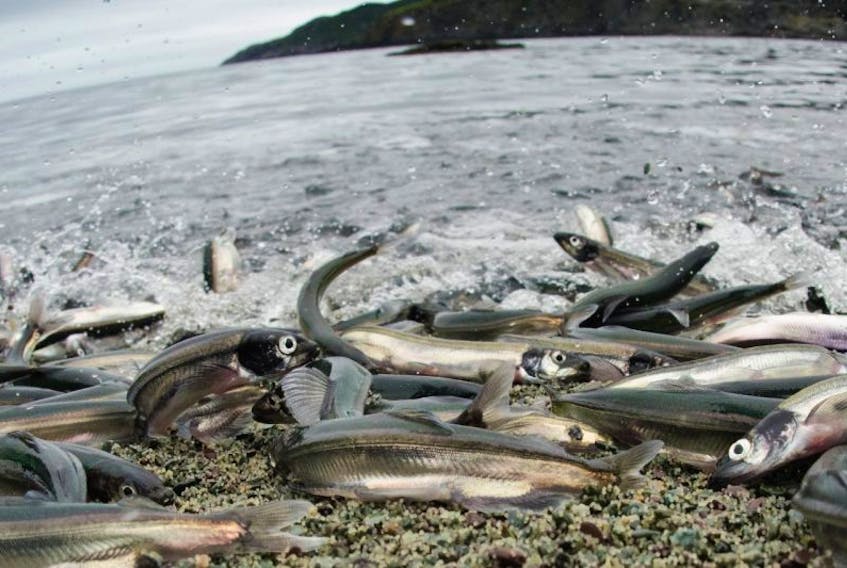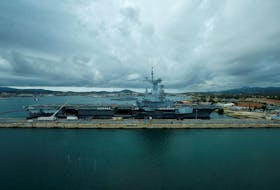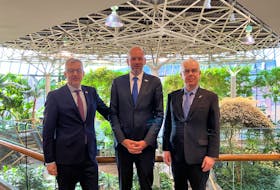With capelin flooding the beaches and nets of harvesters in numbers not seen in years, the abundance and quality of the species is turning heads across the province.
Fixed gear harvester Dennis Chaulk had three days fishing capelin in Bonavista Bay from July 23-25. Like the capelin fishers in the Notre Dame Bay region of central Newfoundland, Chaulk witnessed a successful and plentiful fishery.
Chaulk says the capelin that have rolled in June and July to the beaches near his home in Charlottetown are still there.
“This year the capelin have showed up everywhere,” said Chaulk. “Capelin is rolling into every beach it once did 20 years ago. It’s almost like were patterning back to that.”
Fish, Food and Allied Workers Union inshore director Bill Broderick, has a conference call with harvesters across the province every morning at 11 a.m. With the exception of the northern reaches of the island, he says these bountiful signs of capelin are showing up on nearly every cove and bay around.
But according to the scientific projections given from the Department of Fisheries and Oceans (DFO) earlier this year, these capelin signs were not the expected turn out.
According to a technical briefing from the department back in March, capelin larval production was supposed to be at its lowest rate in the past four years. The briefing also projected the capelin stocks to experience further declines in both 2018 and 2019.
DFO research scientist Dr. Hannah Murphy specializes in the study of pelagic species like capelin. She says this year’s March projection was based on surveying work and data collected in May of 2017. The survey they did in the 3L region, the larvae they collected in Trinity Bay, and the commercial data studied all indicated a negative outlook for capelin.

Needs to be scrutinized
But now that harvesters and buyers across the province are saying it’s the best quality and population of capelin seen in over two decades, Broderick says this summer’s capelin fishery has shown that the science available on capelin is far from accurate and needs to be seriously scrutinized.
“This just acknowledges what we’ve been saying for some time now – we don’t have good science on capelin,” Broderick said. “And the DFO will admit we don’t have good science on capelin, yet they’ll use that little bit of science to cut quotas and take away from people’s livelihoods.
“Now we’re out looking for make-work projects for plant workers when they could have easily gotten another few weeks processing capelin.”
Murphy believes that the mild winter and early returns of harbour ice from the bays of the island is a likely factor in this sudden abundance of capelin.
“Like other pelagic species, when conditions are good they can really take advantage of that and recover rather quickly. It makes the capelin difficult to forecast,” Murphy said. “We had a fairly mild winter, early ice retreats, food available early – this may have really improved the survival of capelin.”
For this year’s capelin assessment work has expanded in the lead up to the next assessment in March of 2019. In partnership with the University of Manitoba, DFO are helping analyse larvae production in the 3K region, near Twillingate, as well as continuing their work with larvae in Trinity Bay.
Because weather conditions can cause major and quick changes in capelin populations, Murphy says the department is also working towards a forecasting model that will be further discussed at their assessment announcement next year.
“To get a better grasp on this and predict some of this unpredictability, we’re trying to develop a forecast model using three important variables,” Murphy said. “We’ll be looking closely at the retreat of sea ice, which tells us when the spring bloom is going to happen, incorporate larval abundance index, and study the fall conditions of capelin.
“Now that we’re on to an annual stock assessment, it allows us to adapt our advice and react quickly.”
Because of plentiful signs of capelin in the traps and herring nets of crab harvesters earlier this spring, Murphy says DFO scientists studied capelin in the bays and collected data from these harvesters as well this year.
Frustrating
For fisher Chaulk, the unexpected abundance of capelin hits particularly hard — knowing he cannot take advantage of this abundance due to the quota reductions based on the March assessment.
With so much of the data gathered in the month of May, Chaulk says DFO should spend more time on the water with harvesters while the capelin fishery is in full swing,
“It’s frustrating as a harvester. Seeing how things are this year, we should have never taken the cut,” he said. “In all my years of fishing it’s the biggest capelin I’ve ever seen. But like our cod and our crab [quota], once they get cut it seems like it’s an awful fight getting them back.
“There’s no doubt we need to get a truer picture of what we got in the ocean – that’s the bottom line of it.”
Murphy says the offer to go out in boat with capelin harvesters during the fishery has been around for some time. She says the department is open to further discussions on this offer.

Need for accurate science
Now looking ahead to the upcoming commercial cod fishery, that also took a reduction in quota this year, Broderick says he’s hearing across the board that the cod are now looking fatter and healthier than previous years.
With the continual talk of a returning ground fishery, Broderick hopes that any future decisions on quota changes are backed up by the most verifiable and accurate science available.
“We’re trying to build back an industry here; we’re trying to encourage people to go back to fishing cod,” Broderick said. “We’re getting new boats and new equipment so we can catch quality fish and get a good price for it. But at the same time we’re losing opportunities because of poor science and poor management.
“So if they’re going to reduce and chop down our fisheries, they better have good science to back it up.”
- Want in on the debate?
- Write us a letter to the editor and email it to [email protected]. Be sure to include a name, address and daytime telephone number where the author can be contacted. Letters should be no more than 300 words.
Related stories:
First two days of capelin fishery around Twillingate proving successful









